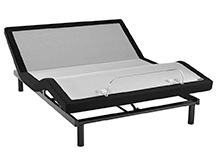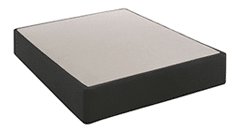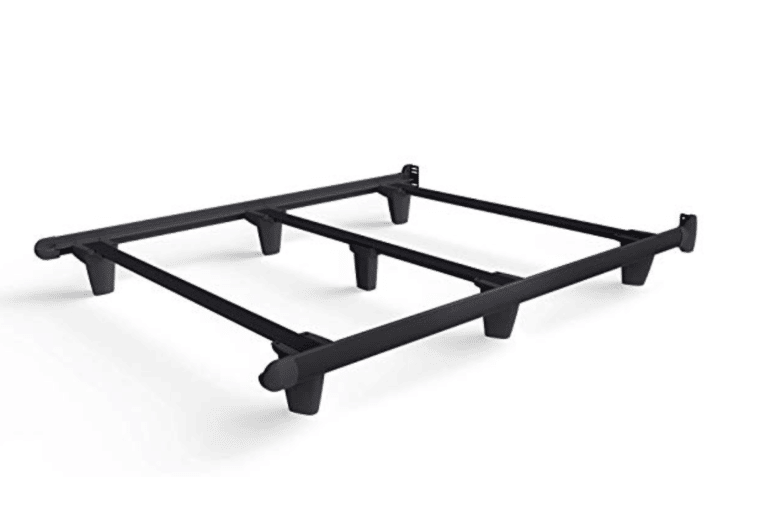
Undeniably, the mattress base you choose is essential if you aim to keep your mattress long-term. The base for your bed can increase or decrease the mattress’s potential lifetime, which lasts approximately seven to 10 years.
After all, like a foundation for a home, once a structural crack takes place, it often lessens the foundation’s integrity and ability to support the home itself. The same goes for your mattress, as the box spring is the foundation of your bed. So the natural question is: can you put a new mattress on an old box spring?

Noisy Boxspring Keeping You Up at Night?
Suppose the box spring you’re using is old and performing differently than it used to when you first got it.Do you hear noises or loose parts inside the box or notice more movement when you turn from side to side?
Just like the cause and effect of a home’s compromised foundation, putting a new mattress on an old box spring will gradually compromise it over time, typically in the form of dipping, sagging, and a lack of support or an ‘I hate this mattress’ feeling.
Luckily, as many of us have become accustomed to calling it, an old box spring is much easier to replace and more economical than the foundation of your home. Box springs are often not worth the hassle of attempting to repair because they need to be rigid and structurally sound to offer legitimate support for the mattress. In the end, it’s less cost-effective to put your new mattress on an old box spring versus investing in a new box spring.
The box spring is not just a base for your mattress intended to add overall height to the bed itself; it’s a structural foundation that supports you and your sleeping surface. A sturdy foundation is necessary for a long-lasting, reliable bed, maintaining the strength to hold the weight of the mattress and sleepers on top. This is why you shouldn’t put a new mattress on an old box spring. It’s like the backbone of your bed, providing the necessary support for a comfortable and restful sleep.
The primary purposes of box springs are to offer rigid stability for the mattress on top and serve as a ventilation system through the base to avoid trapped heat or unwanted moisture.
Gilded Era ‘Bedsprings’ Blossom Into ‘Box Springs’
Unlike today’s modern furniture, the original spring-supported rectangular wire frames didn’t have any wood framework inside the box. In the late 1800s, bedsprings comprised metals, steel, and wire-tied coil units wrapped in fabric and designed to support cotton, feather, and horsehair mattresses.
Invented in 1883 by J.P. Leggett and C.B. Platt before forming Leggett & Platt in 1885, the original spring cushioned boxes were called bedsprings. Later, bedsprings were further developed, and manufacturers, like L&P, began utilizing wooden material for the framework. This more advanced design, a box spring, was more suitable for introducing new mattress styles with different needs for adaptable but rigid support.
So, modified from the bedspring, the original box spring design was born. The box spring was innovated based upon the all-metal bedspring, with its metal and spring composition, refitted to a wooden framework with a cushioned spring unit to accommodate flippable mattresses. The box spring, also known as a ‘divan’ in countries like the United Kingdom, was a helpful trade-off to accommodate the comfort layers of double-sided mattresses. The springs within the box spring made the foundation more adaptable, retaining support but also gently protecting the mattress’s delicate padding layers on both sides of the flippable mattress. Ultimately, box springs originally enabled a double-sided mattress to last longer, avoiding the compression of the padding layers between the mattress and base. Being that these were created during the Gilded Era, they probably weren’t putting a new mattress on an old box spring either!
Catering to the delicate comfort laters on both sides of double-sided mattresses was a box spring’s main prospect for utilizing springs inside. In the past, protecting both sides of the flippable mattress is what the springs inside the box spring did best.
Handmade boxes like these are still available today, from brands like Kluft or Aireloom, who curate exceptional-quality, hand-tufted California-design mattresses and eight-way hand-tied box foundations.
As years passed, the bedding industry shifted toward wooden products, and the need for actual springs inside the box spring diminished along with the flippable mattress. And over time, the manufacturing of bedsprings, double-sided mattresses, and box springs with springs has faded slowly but surely. Today, manufacturers have shied away from creating double-sided mattresses, except sometimes specifically for hotels and hospitality mattress lines generally not available for retail sale to consumers.
Today, with modern-style box springs, the use of springs is slim to none. Oddly enough, they’re still often called a box spring, now going hand-in-hand with the term ‘foundation.’ Many today, including bedding experts, refer to them as a mattress box, box spring, a foundation, a box spring foundation, or box foundation. Not to be confused with bed-in-the-box or rolled mattresses that offer convenient transportation from start to finish. Box foundations today are typically paired with a metal bed frame and a new mattress, as you wouldn’t want to compromise your sleep health by putting a new mattress on an old box spring.
Box springs of today consist of slat-like beams made from steel, posted on a wooden framework, and covered in fabric. Sometimes, although less breathable, particleboard or pressboard creates a more solid box foundation surface on the top. However, good quality box spring foundations, like the Leggett & Plat Semi-Flex Foundation, won’t use any pressboard and offer increased ventilation. The best box spring foundations are made from high-quality wood for the framework, with steel slatted beams that form structural stability for the mattress.
Box foundations allow for breathability similar to the original box springs with springs. Still, springs are no longer needed, as most mattresses made today are no longer flippable or double-sided. With a current bed, a monthly rotation of the mattress from head to foot replaces a twice-yearly or quarterly mattress flip, the prior recommendation for a double-sided mattress design. With that, the evolution of mattresses from two sides to one, including the ‘box spring foundation’ complete without springs, was established.
Once you’ve picked out your new mattress or bed frame with a headboard, many people often seek the answer to this common question: Do I really need a box spring with it? And if so, can I get away with a new mattress on an old box spring?
Most consumers today aren’t mattress nerds and sleep geeks like us, which makes finding the answer to these questions sometimes more challenging than you anticipated.
Before consistent labeling, furniture companies didn’t distinguish products with tags like ‘box spring required.’ Today, many furniture manufacturers are developing fool-proof designs with universal parts and setup formats, making pairing your furniture with your mattress or frame easier than ever.
Many people today seek a minimalist, simple, fresh, or contemporary interior design style inside the home and bedroom, making the urge to ditch the box spring more desirable than ever. And, with innovative technology, options like a modern platform with storage drawers or a multi-functional adjustable bed are making design for the bedroom more intriguing than ever before.
The answer is that it solely depends on the frame. As mentioned above, a box spring is unnecessary for most platform beds. Suppose your platform has 12 to 20 horizontal slats that are no more than 2.5 to 3 inches apart. In this case, the platform bed offers adequate support, requiring no additional rigid support or box to complete the structure. Say the slats are few and far between, creating gaps of 4 to 12 inches. If this is the case, you should add a box foundation. And, as you are likely able to guess by now, for the sake of your wallet and your sleep health, please don’t put a new mattress on an old box spring.
Especially with a foam or latex mattress, a box spring ensures the mattress won’t sag, warp, or wear prematurely from gaps in support. With slats spread too far apart, the mattress will slowly sink, and eventually become warped or damaged from the expanded space without the extended support of the additional unyielding surface.
A panel bed frame, often consisting of a decorative headboard and footboard piece, will also frequently require a box spring, low profile box spring, or a bunkie board. A panel bed frame consists mainly of the ‘paneling’ or decorative portion of the bed, so an extra support system is needed, requiring the addition of a box spring foundation.
A box spring foundation is the most straightforward complement to the traditional mattress and Hollywood Frame. Today’s mattresses are available to purchase alone or amongst the set, including the additional support box, also known as the box spring foundation or bunkie board. Typically, a box spring comes in two different heights: five or nine inches. Optional bunkie boards satisfy the need to pair with an ultra-thick mattress (14+ inches) or fulfill an ultra-low profile look, with the bunkie board only boosting the bed by 1.5 to 2 inches.
Some panel bed frames, like canopy beds, sleigh beds, and even some wooden or upholstered beds, are complete with only 3 or 4 horizontal slats included. With only a few slats, they sit far apart from each other across the side rails. Significant gaps between the rails, more than 2 or 3 inches apart, can be considered insufficient support, especially for all foam or latex-style mattresses. A ‘box spring required’ tag alerts buyers to be sure to add additional support to the framework to ensure the longevity of the mattress and bed frame.
In many cases, without the addition of the box spring, proper slat count, and center support for Queen and King sizes, the warranty of the mattress is null and void by the manufacturer. Many mattress companies require consumers to follow precise requirements detailing the proper use of their brand, knowing full well that not all bed frames offer instant sufficient support without a box or additional foundation piece. This is another financial reason not to put a new mattress on an old box spring.

Have you ever heard that crunchy, creaky sound from your mattress or bed base? Sometimes, it’s difficult to tell where that mysterious sound starts and where it ends, but either way, noises like this cause unwanted sleep disruptions and motion transfer between multiple sleepers. Without further inspection, it’s safe to say you need a new box spring. You might even need a new mattress, too, as more often than not, a broken box spring foundation over time leads to a worn-out, low-performance mattress susceptible to dipping, sagging, and a lack of support for the sleepers.
Once wooden components, steel coils, or beams become damaged, they tend to make noise. Cracking or creaking tends to be a wood-upon-metal sound effect. Crunching or squeaking typically describes broken down or defective coils within the mattress itself. But of those who’ve dealt with noise within their foundation, according to Leggett and Platt, a major US box spring manufacturer and supplier, about 85% of those boxes were all-wood box foundations.
You can tell if you need to replace your box spring by examining, through touch and feel, the overall stability of the steel beams while noticing any noise. Carefully run your hands along all sides of the box spring to ensure there are no visible bowing, cracks, breaks, structural damages, or defects that compromise the base. You will want to ensure that there aren’t any damaged parts or noticeably broken spots in the wood or steel components or free-floating pieces inside causing noise.
Do you notice noise coming from your box spring foundation or mattress? If so, it is likely that something just isn’t quite right. Replacing one or both pieces can help you avoid unwanted deterioration to the mattress over time, often resulting in a lack of comfort support for the sleeper. Discomfort, often in the form of the mattress dipping, sagging, and more potential noise or motion transfer from damaged parts, is usually caused by a compromised foundation or defective mattress, causing unnecessary and avoidable sleep cycle disturbances.
So, avoid the constant chatter or movement with an insufficient mattress support system, and replace your box spring, or even upgrade to an adjustable bed if you hear any noise. After all, your sleep is only as good as the surface you dedicate to rest on, so it better be a good one. An innovative adjustable bed can make all the difference for a bed that consistently feels ‘’just right.”
Because two people weigh more than one, if more than one person is sleeping on the mattress, especially if one is big or tall, husky or muscular, you’ll need a sturdy bed base. For bigger body types or with multiple sleepers, the bed base becomes particularly important to manage sleep disruptions from movement, noise, or bounce. The need for a sturdy support base makes an adequate box spring or platform particularly important in creating a cohesive mattress and box foundation combination that fits your lifestyle.

As we all have discovered by now, your comfort only lasts as long as the mattress does. Considerably, just like the construction of your home, the mattress only has the potential to last as long as its foundation does. Most of the time, it is in your best interest to replace the mattress and box spring together. Or, opt to utilize a more modern, sophisticated bed base, like a platform foundation or adjustable bed frame.
Mattress World Northwest is eager to supply the best selection of top-tier brands, including box spring foundations, adjustable beds, and platform options too.
As a specialty mattress store with a positive and humble company culture, you can be assured that our sleep specialists and qualified support staff will help you solve your mattress, bed base, or old box spring dilemma.
With Mattress World Northwest’s standard white-glove delivery service, we will even bring out your new products and haul away and recycle your old items, like a mattress and box spring!
So, don’t hesitate to develop or reinvent your framework for better sleep, starting from the ground up, with a sufficient box spring foundation, Hollywood frame, platform, or adjustable bed. Check out our carefully chosen selection of mattress bases and box spring foundations in our online shop or at one of our specialty sleep shop locations near you.
Mattress World Northwest sleep specialists offer the sleep expertise you need; we specialize in the science of true comfort. Resilient and healthy sleep victories await you and your loved ones, made possible by a Mattress World Northwest specialty sleep shop near you!
Updated: 10/28/2024
« How Often Are You Supposed to Get a New Mattress? | Best Place to Buy a Mattress in Oregon »
While you can't go wrong with any of our mattresses, here are a few factors you'll want to consider before making a purchase: your sleep position (and if you have a partner, theirs as well), the size of the space, and a price point. If you have any questions, rest easy knowing that our team is happy to help you find that perfect fit.
| Size | Dimensions |
|---|---|
| Twin | 38″ wide x 75″ long x 9.25″ tall |
| Twin XL | 38″ wide x 80″ long x 9.25″ tall |
| Full | 54″ wide x 75″ long x 9.25″ tall |
| Queen | 60″ wide x 80″ long x 9.25″ tall |
| King | 76″ wide x 80″ long x 9.25″ tall |
| Cal King | 72″ wide x 84″ long x 9.25″ tall |
| Split King (2pk) | 38″ wide x 80″ long x 9.25″ tall |
Mattress World Northwest makes it easy to choose the right foundation for your space and lifestyle.



Reliable support for your boxspring and mattress.
